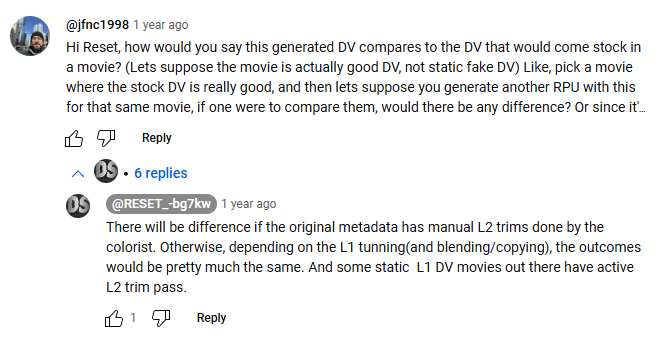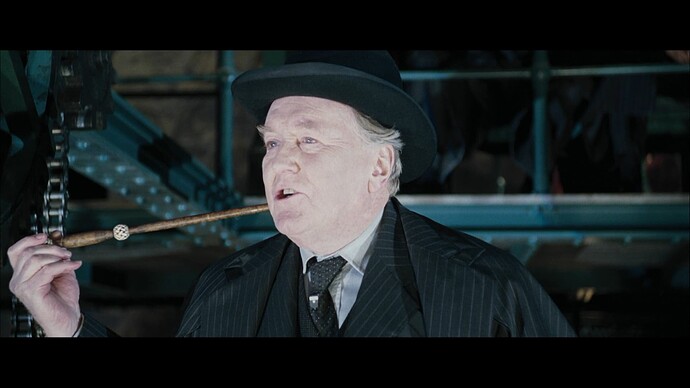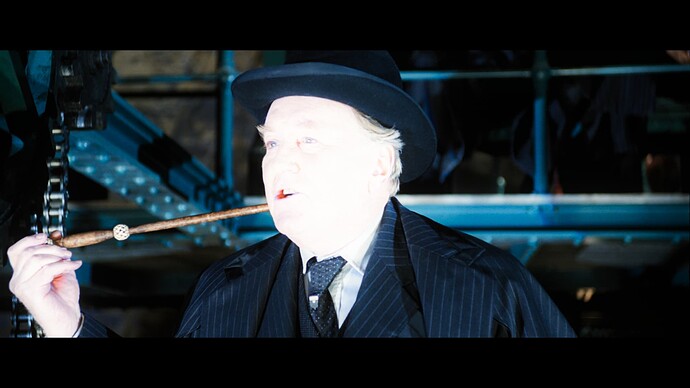Yes, night and day. I have adjusted some settings on that but not the brightness
On the C8 Cinema is darker and Cinema Home is lighter.
Weird that there would be such differences between generations, especially since the qoutation you posted from RTINGS says switch to Cinema Home if you find Cinema too dark.
I don’t expect them to be identical obviously but you would think the trend of Cinema Home being lighter to remain instead of flip.
Yeah but maybe OLED LIGHT, or Peak Brightness
Well, even the HDR10 only retail clip apparently has all the information too, since you can see his cheeks and the rings better when the Vero V dims the display after awhile as both Ainsley and I have witnessed AND enabling Dynamic Tone Mapping gets it as well BUT I think the goal here is that the Vero V displays the clip “proper” without any radical changes being made on the TV side.
Again, I say “proper” in quotes because OPPO and Sony UHD players don’t do any better and it appears that the reference has now become how it’s displayed on the Ugoos.
Since ac16161’s clip is DV Profile 8 I have to imagine that the Vero V is capable of matching the desired results of the Ugoos.
I can’t get my C8 to show the HDMI Mode Diagnostics but ac16161 might be able to.
I know he mentioned what his AVR says but it would be nice to see what the TV says as well.
at default - both are 100 for oled/ peak brightness.
Perhasps a fw update changed the overall picture
this clip I’ve shared is retail HDR10 with DV injected via automated analysis. All the information is there, it just turns out that there are TVs on the market that don’t do a great job of playing films that go up to 6000 - 10000 nits (who figured?). Some of the HP films peak at 10000, as does Argo.
I think the OPPO has lost its crown. It’s now possible to construct mkv’s that for some titles are superior to retail discs (e.g. DV CMv4-injected versions of any ultra-high brightness HDR10-only release).
with TV-led DV, that’s my expectation.
I’ve not found any leads on how to pull up HDMI diagnostic stats on a Panny OLED in the way you can with some LG’s.
I need to learn DoVi_Scripts.
When you take the WEB DV and inject it into the UHD disc remux, the assumption is that the WEB DV was generated from the master (we don’t know that though, maybe Apple, Disney, Netflix, etc. are just doing the same thing that DoVi_Scripts does), but making your own DV via Resolve makes me think, how much better is Resolve at generating this dynamic metadata than my TV is on the fly?
If the results are essentially the same then why not just turn on Dynamic Tone Mapping on my TV then?
If the master was done in DV, but the disc was authored in HDR10 only, and the WEB sources are using the DV master, then a purist could justify the WEB DV inject, but if it’s not then I question, from a purist perspective, why is DoVi_Scripts any better than the TVs Dynamic Tone Mapping?
Sure the results from DoVi_Scripts may please your eyes, but is it accurate?
Heck, who even cares maybe?
If we can do a better job with open source software at authoring remuxes then the people pressing the discs, then why not, right?
Are not Star Wars fan edits superior to the garbage Lucas and Disney are trying to rip us off with?
To some, for sure; others may disagree though.
I’m going to play with DoVi_Scripts and do some comparisons.
I’m just trying to think what would be the most objective way to do that.
Maybe take a UHD that has DV and strip the DV out so it’s HDR10 only, then feed that into DoVi_Scripts to generate new DV and then A/B compare those results with the actual disc with DV.
Can you think of any UHD discs that have brutal scenes like the Harry Potter examples but actually have a DV layer on the disc?
That would seem to be the best test.
For what it’s worth I found this answer from Reset_9999 in the comments of one of his videos:
This maybe of interest:
If this company, which provides QC, is correct then Netflix doesn’t generate DV at all and that metadata needs to be there when the content is delivered to them.
Not sure what Apple does though because their streams have been historically different then others when it comes to DV.
We’re probably getting to off topic at this point though, unless this information is also helpful to the OSMC devs for what they are trying to accomplish.
it’s a very powerful toolset.
yeah, I’ve never tried third-party RPU’s, though the DoviScripts author has a large collection that can be accessed if you make a donation. My focus as been on the workflow that runs the analysis using the official Dolby CM Analyze tool.
I’ve not run that test. What I would say however is that the DoviScripts workflow supports a deep-level analysis that I imagine would be more sophisticated than any form of on-they-fly conversion., but who knows, maybe I’ve wasted my time.
I’ve had this thought too. My P7 MEL collection is very small, and most of the titles have low nits grades and/or entirely static RPUs (Aliens, The Abyss and The Terminator all have DV that is just a marketing gimmick). The Lord of the Rings films probably have the highest peak nits among my MEL collection, I haven’t got around to plotting these yet, but the plots may give me a pointer to a suitable test scene.
I have a decent number of P7 FEL titles, I haven’t looked at re-generating their RPUs in case that messes with the FEL, I think that requires deeper expertise than I have to manage. But again, even some FEL titles have static RPUs (yes, Cameron titles again, Titanic and True Lies). I think a bright MEL title would be the best bet for fair comparison.
We’re all learning here, but what I would say is this. Dynamic tonemapping by your TV can only look so far ahead. What the DV CMU does is take the video scene by scene (although sometimes frame by frame). That gives it a better look-ahead than your TV can do. And as Reset says, a colourist can add or adjust trims to get it looking just so for displays < master display. I haven’t examined the RPUs generated by DoviScripts or Resolve to see if they do add trims.
P7 FELs when converted to P8 without the enhancement layer and mashups where the WEB RPU is grafted onto a HDR10 base layer seem to me likely to be worse than a P8 made by DoviScripts using the official DV black box.
And which titles have this been done on?
Who knows?
But that would be manual tweaking that the colorist had done that the DoVi_Scripts obviously wouldn’t be doing.
And if the colorist did that on a DV master, and this was turned over to Netflix, then I would have to think that injecting the Netflix WEB DV into the UHD would be more accurate than using DoVi_Scripts (for purists).
But I suppose there is no way for us to know such things.
We just do the best we can with what we have I guess.
Honestly, I doubt any of these studios do much when it comes to DV for UHD discs.
Maybe on big name titles, that are not from James Cameron, they pay to have such things done by colorists.
But I would bet that the majority of DV discs are just ran through scripts.
workflow 6-4 will plot all the levels for a DV input. I’m going to work through that at some point for my collection of retail DV titles.
potentially. I think you would need to check that the downloaded RPU is in sync with your local HDR10 file and is indeed the correct one for your release. I’ve not looked at the tools that support sync checking as I decided early on I would prefer to generate DV from my own HDR10 files - that way sync is a given, and I know it’s adjusting for my specific release of the film.
And in terms of worrying about accuracy, I would offer the following: I’ve seen HDR10 presentations that look way off even when I’ve gone to the trouble of setting up my display using Spears & Munsil. Sometimes I can’t believe that what I’m seeing is anywhere near what the director would have wanted me to see (Hardy’s face in GoF being an egregious example). In such cases the DV-generated version will be much better, and I suspect much closer to what was intended. Will it be absolutely the last word in pin-point adjustment for every shot? No. But it will be a lot better than the vanilla version.
One would assume that the original BD is most likely what was intended:
And that the the UHD guys got carried away:
Personally, all the Harry Potter releases of this film look like garbage, likely because they were early adopters to their respective formats.
The BD came out a year after BD hit the market, as did the UHD.
The BD is plagued by a horrible VC-1 encode (presumable ported over from the HD-DVD).
The macro blocking in the dark areas is insane.
My son and I were joking that it looked like someone was playing Tetris in the shadows.
The UHD obviously went light canon mode with the HDR grade.
I’m sure glad I’m not a Harry Potter fan, these movies would drive me nuts!
Does anyone have P8 or P7 MEL test files? I only have P5 and FEL test files, leaving quite a gap. Apart from my TV displaying a DV logo with P8 content, I’ve not seen any evidence that the V is handling DV correctly with respect to highlights, but I’ve not recently checked for updates. If DV support is about to become official, does that mean the OSMC team is of the view that DV is working correctly across standard profiles?
There are some more adjustments in the next release which address the Potter problem. I think the team is pretty happy with how it is, now. We couldn’t have done it without your and other testers’ help.
Those changes are live for testing now and will be included in the Sunday release.
If you’d like to test them now that would be great.
Sam
We’re not expecting DV Profile 7 to do anything other than pass on the RPU correct?
So no FEL.
P5 and and P8 should be perfect.
I can make test files of whatever you want, just let me know.
I have titles that are P7 MEL (I think all the James Cameron titles are P7 MEL if I remember correctly), you should have P8.1 files to test, P8.4 might be hard to come by though.
thanks, I probably wasn’t clear. By test files I meant a demo like the P5 “Eagle’s beak” that shows whether CMv4 is working. I don’t have a P8 equivalent.
great, hope to test later today.
No changes for me regarding the GoF DV clip with the latest update.
no change here with the GoF clip. My system is reporting a Feb 20 compilation date, 4.9.269-79.


